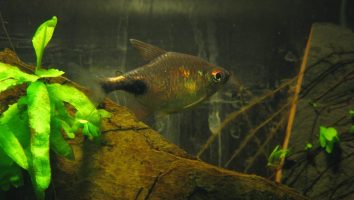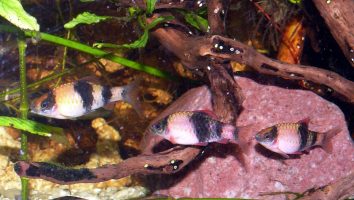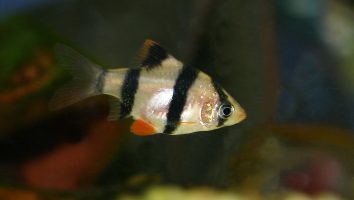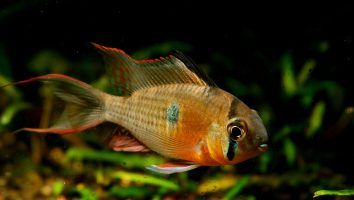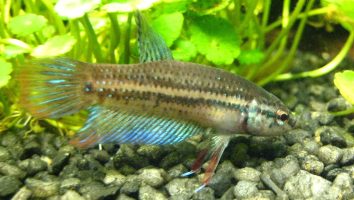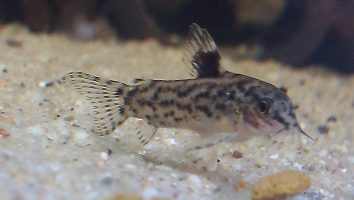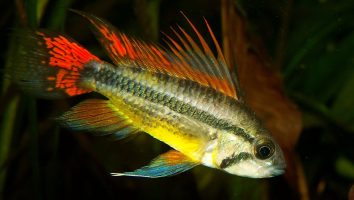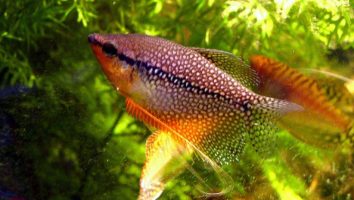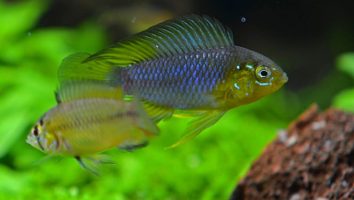Black mollies are a beautiful and popular freshwater fish that are easy to care for. They’re a great addition to any aquarium and will quickly become one of your favorites!
But before you go out and buy one (or a few), there are a few things you need to know about black molly care. This guide will teach you everything you need to know, from diet and tank size to lifespan and breeding.
Table of contents
Species overview
Black mollies (Poecilia sphenops) are a type of livebearing fish that is native to fresh and brackish waters in Mexico and the southern parts of the United States.
Black mollies are relatively easy to care for and are a popular choice for beginner aquarium enthusiasts. They are peaceful fish that do well in community tanks and can be kept with a wide variety of tank mates.
These fish are known for their hardiness and their ability to adapt to a wide range of water conditions. They are also one of the few livebearing fish that can tolerate brackish water.
Black mollies are a popular choice for aquariums because they are relatively easy to care for and have a wide range of tolerance when it comes to water conditions.
Appearance
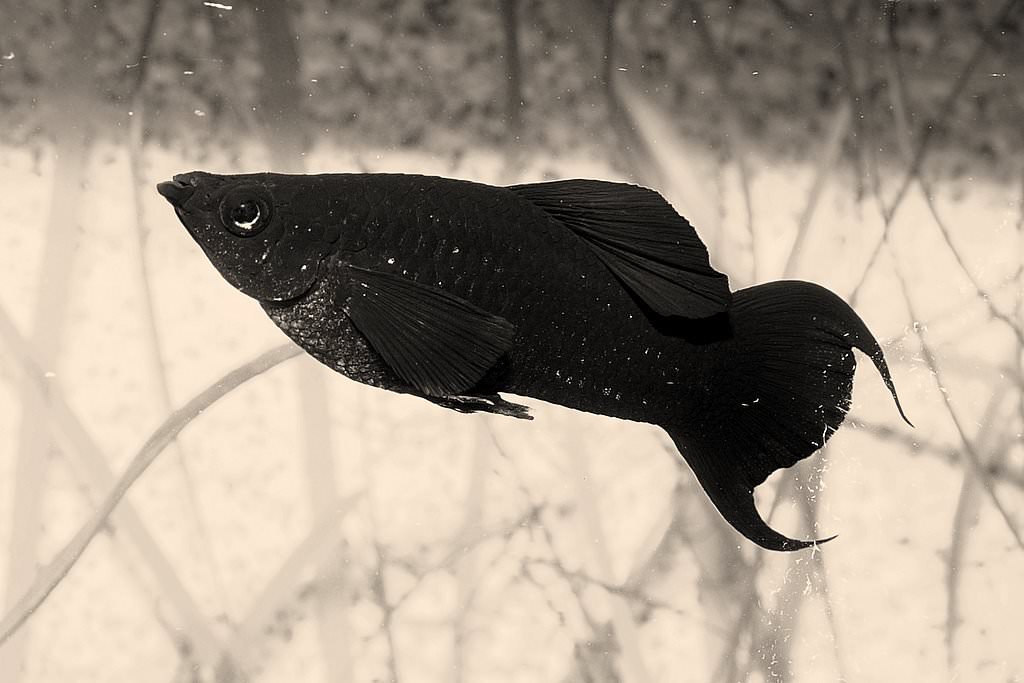
Black mollies are a beautiful species of fish that are loved by many aquarists. As you can probably guess from their name, these fish are mostly black in color.
The black coloration on these fish is pretty consistent all over their body. The only exception to this is their fins which are mostly clear with a little bit of black shading near the tips.
The fins on black mollies are rather large and flowy. The dorsal fin starts about two-thirds of the way back on their bodies and extends all the way to the end of their caudal fin.
The anal fin is similar in size and shape to the dorsal fin. Both of these fins have a bit of a ragged look to them due to the way the black shading extends into the clear parts.
The caudal fin is forked and relatively large. The pectoral fins are also large and flowy. Black mollies have a very elegant look to them when they swim.
Lifespan
Black mollies have an average lifespan of 3 to 5 years, although some have been known to live up to 10 years. Their lifespan largely depends on the quality of water they live in and the care they receive.
Black mollies are very sensitive to changes in water quality and will not do well in an environment that is not well-maintained. They are also very sensitive to overfeeding, so it’s important to be careful not to overdo it when feeding them.
Size
Black mollies can grow to be about 4 inches in length, but they are typically closer to 3 inches. These fish are known for their hardy nature, so they can do well in a variety of different tank sizes.
Tank
Tank Size
The recommended minimum tank size for black mollies is 10 gallons. If you’re looking to keep a small school of these fish, this is the minimum size tank you’ll need.
Keep in mind that mollies are livebearers, so if you have a female molly in your tank she may give birth to anywhere from 5 to 100 fry at a time. If you’re not interested in breeding your mollies, we recommend keeping at least 1 male for every 2 females. This will help cut down on the number of fry born.
Water Parameters
Mollies are a bit more sensitive to water changes and water quality than some other freshwater fish. They’re not as adaptable as, say, a guppy.
That’s why it’s important to maintain consistent water parameters. Black mollies are used to living in brackish water with a high salt content. They also like their water on the warm side with plenty of oxygenation.
While you don’t need to add salt to your freshwater tank, you should try to maintain similar water conditions. That means regular water changes and a high-quality filtration system.
Here are some basic water parameters to help you create a healthy environment for black mollies.
- Water Temperature: 72 to 82 degrees Fahrenheit
- pH Levels: 7.0 to 8.5
- Water Hardness: 10 to 30 dGH
- Alkalinity Levels: 2 to 12 dKH
What To Put In Their Tank
When it comes to setting up an aquarium for black mollies there are a few things to keep in mind.
First and foremost, these fish are going to need some room to swim. They’re not the biggest fish in the world, but they’re not small either. A 20-gallon tank is the bare minimum we would recommend, but something a little larger would be ideal.
The other thing to consider is the fact that mollies are known to be jumpers. They’re not the best at it, but it can happen from time to time. This means you need to make sure their tank is covered.
Other than that, you can pretty much use any standard aquarium setup for black mollies. They’re not too picky when it comes to decorations or plants.
A gravel substrate is always a good choice, but feel free to switch it up if you want. Just make sure whatever you use is smooth so they don’t hurt themselves.
As for plants, anything that can tolerate a little bit of salt will do just fine. Hornwort, Java Fern, and Anacharis are all great choices.
Common Diseases
The Black Molly is a relatively hardy fish, but they are still susceptible to a few common diseases.
The most common disease that affects this species is ich. This is a parasites that can cause a lot of problems for your fish if it’s not treated quickly.
The most obvious symptom of ich is the presence of white spots on the body of your fish. If you notice this, it’s important to act fast and begin treatment immediately.
There are a few other diseases that can affect the Black Molly, but they’re not as common. Some of these include swim bladder disease, fin rot, and bacterial infections.
As with any other fish, the best way to prevent disease is to maintain clean and stable water conditions in their tank. A well-maintained tank will lead to healthier fish who are more resistant to disease.
Behavior & Temperament
Black mollies are another popular freshwater fish that is known for being relatively peaceful. In the wild, they can be found in warm waters throughout the Americas.
Although they are peaceful, mollies can be a little nippy. They may nibble on the fins of their tank mates. So, it’s best to keep them with other fish that have similar body shapes. That way, they are less likely to mistake another fish for food.
Mollies are also known to be good jumpers. So, it’s important to have a tight-fitting lid on your aquarium. Otherwise, they may make a break for it and wind up on your floor!
Black mollies are social creatures and do best in groups. So, it’s a good idea to have at least six of them in your tank. That way, they can school together and feel more comfortable in their environment.
When it comes to temperament, black mollies are relatively peaceful. They are not known to be aggressive towards other fish. However, they can be a little nippy. So, it’s best to keep them with other fish that have similar body shapes.
Tank Mates
Black mollies are peaceful community fish that get along with most other species.
Since they come from brackish and freshwater habitats in the wild, they’re adaptable to a wide range of water conditions.
This makes them an ideal choice for beginners since you don’t need to match their water exactly to what they’re used to.
Black mollies are also livebearers. This means they give birth to live young instead of laying eggs.
As a result, they’re often kept in pairs or small groups since they tend to do best in numbers.
Some compatible black molly tank mates include:
- Guppies
- Platies
- Swordtails
- Mollies
- Endler’s Live Bearers
- Corydoras Catfish
- Neon Tetras
- Dwarf Gouramis
Breeding
Black mollies are livebearers, meaning they give birth to live young instead of laying eggs. They’re easy to breed and make great beginner fish for those just starting out in the world of fish breeding.
To start, you’ll need to set up a breeding tank. It should be at least 20 gallons and contain plenty of hiding places. Mollies like to have a lot of plants in their tanks.
Since black mollies are livebearers, you don’t need to worry about triggering spawning. The female will drop her fry (baby fish) when they’re ready.
It’s a good idea to remove the fry to a separate tank once they’re born. That way, they won’t be eaten by the adults. You can feed them live foods or finely ground flake food.
As they grow, you can slowly introduce them back into the main tank.
Conclusion
The Black Molly is a great beginner fish and a perfect choice for someone who wants a low-maintenance pet.
They are peaceful, hardy, and easy to care for, making them a great addition to any community tank.
While they are not the most exciting fish in the world, they are a great option for someone who wants a pet they can enjoy without a lot of hassle.

